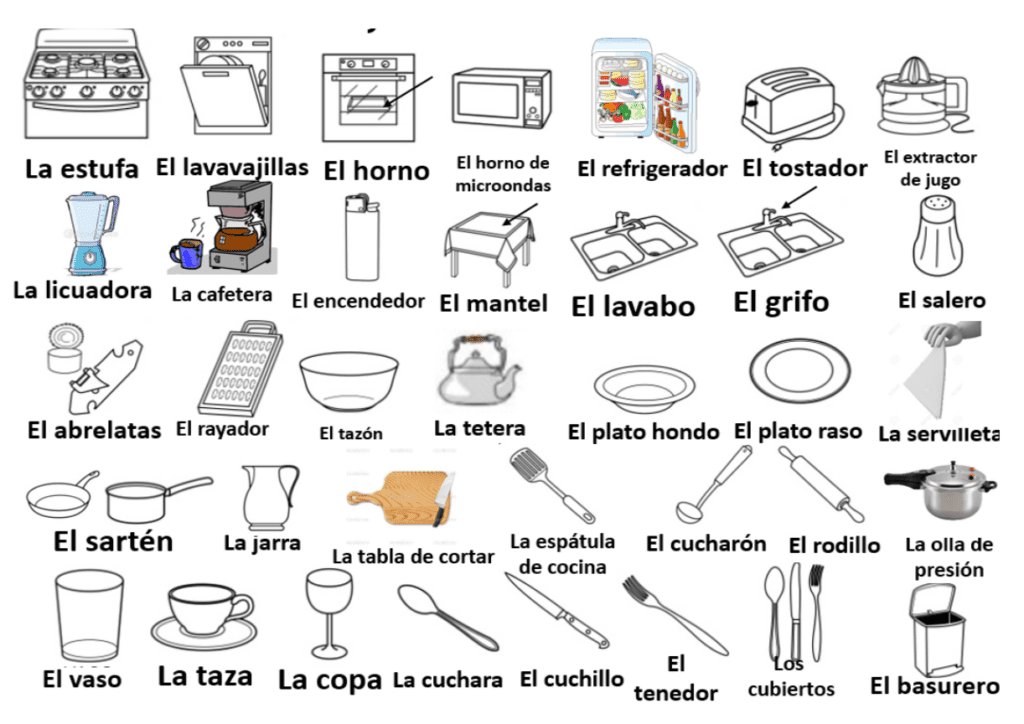Learning a new language can be both exciting and challenging at the same time. However, one of the best ways to learn a language is through practical and everyday topics, such as the parts of the kitchen in Spanish. In this article, we will explore the parts of the kitchen in Spanish, give you tips for learning the language, and address some common misunderstandings. Get ready to dive into the world of Spanish as you get to know your kitchen!
I. Main Parts of the Kitchen in Spanish
- Appliances (Los electrodomésticos) a. Refrigerator (La nevera / el refrigerador) b. Oven (El horno) c. Stove (La estufa / la cocina) d. Dishwasher (El lavaplatos) e. Microwave (El microondas)
- Furniture and Storage (El mobiliario y almacenamiento) a. Cabinets (Los gabinetes / los armarios) b. Shelves (Las repisas / los estantes) c. Countertop (La encimera / el mostrador) d. Pantry (La despensa)
- Kitchen Utensils (Los utensilios de cocina) a. Frying pan (La sartén) b. Pot (La olla) c. Knife (El cuchillo) d. Spoon (La cuchara) e. Fork (El tenedor)
II. Tips for Learning Spanish Through the Parts of the Kitchen
- Label objects in your kitchen: An excellent way to learn and remember the parts of the kitchen in Spanish is to label objects in your own kitchen with their Spanish names.
- Practice with Spanish recipes: Look for recipes in Spanish and follow the instructions to cook. This will help you become familiar with the vocabulary related to the kitchen and food preparation.
- Kitchen conversations: Engage in conversations with friends or family members who speak Spanish while you’re in the kitchen. Talk about the items you’re using and the steps you’re taking as you prepare a meal. This will provide real-life context for the vocabulary you’re learning and help reinforce your language skills.
- Create flashcards: Make flashcards with the Spanish names of kitchen items and their English translations. Review the flashcards regularly to help commit the vocabulary to memory.
- Watch cooking shows in Spanish: Watching cooking shows or YouTube videos in Spanish can expose you to native speakers using the vocabulary in context. This can help improve your listening comprehension and pronunciation.
III. Addressing Common Misconceptions and Challenges
- Spanish is too difficult: Learning any language can be challenging, but with dedication, practice, and the right approach, you can learn Spanish effectively. Focusing on practical topics like the parts of the kitchen can make the learning process more enjoyable and relatable.
- I’m too old to learn a new language: It’s never too late to start learning a new language. Although it might be easier for children to pick up a new language, adults have the advantage of life experience and a better understanding of language structures, which can aid in learning Spanish.
- I don’t have time to learn a new language: Learning Spanish doesn’t have to be time-consuming. You can incorporate Spanish learning into your daily routine, such as labeling items in your kitchen or practicing with Spanish recipes. Even just a few minutes of practice each day can make a difference in your language acquisition.


Would you like to learn Spanish? We can help you!


IV. Differences in Kitchen Vocabulary: Spain, Argentina, and Mexico
While the Spanish language shares many common words across different countries, some kitchen vocabulary can vary between Spain, Argentina, and Mexico. Let’s explore a few examples:
- Refrigerator:
- Spain: nevera or frigorífico
- Argentina: heladera
- Mexico: refrigerador or nevera
- Stove:
- Spain: cocina or fogón
- Argentina: cocina or anafe
- Mexico: estufa or parrilla
- Dishwasher:
- Spain: lavavajillas
- Argentina: lavavajillas or lavaplatos
- Mexico: lavavajillas
- Kitchen sink:
- Spain: fregadero or pila
- Argentina: pileta
- Mexico: fregadero or tarja
- Drinking straw:
- Spain: pajita or cañita
- Argentina: sorbete
- Mexico: popote
When learning Spanish and focusing on kitchen vocabulary, it’s essential to be aware of these regional variations. By understanding the nuances of the Spanish language in different countries, you can improve your communication skills and adapt to various Spanish-speaking environments.
V. Kitchen items in Spanish: Complete List
Here’s a table comparing the names of important kitchen items in English, Spanish, French, German, and Chinese (Mandarin in Simplified Chinese characters). You can copy and paste this table to use as a reference.
| English | Spanish | French | German | Chinese (Simplified) |
|---|---|---|---|---|
| Refrigerator | Nevera/Refrigerador | Réfrigérateur | Kühlschrank | 冰箱 |
| Oven | Horno | Four | Backofen | 烤箱 |
| Stove | Estufa/Cocina | Cuisinière | Herd | 炉灶 |
| Dishwasher | Lavaplatos | Lave-vaisselle | Geschirrspüler | 洗碗机 |
| Microwave | Microondas | Micro-ondes | Mikrowelle | 微波炉 |
| Cabinets | Gabinetes/Armarios | Placards | Schränke | 橱柜 |
| Shelves | Repisas/Estantes | Étagères | Regale | 架子 |
| Countertop | Encimera/Mostrador | Comptoir | Arbeitsplatte | 橱台 |
| Pantry | Despensa | Garde-manger | Speisekammer | 食品储藏室 |
| Frying pan | Sartén | Poêle | Bratpfanne | 煎锅 |
| Pot | Olla | Casserole | Topf | 锅 |
| Knife | Cuchillo | Couteau | Messer | 刀 |
| Spoon | Cuchara | Cuillère | Löffel | 勺子 |
| Fork | Tenedor | Fourchette | Gabel | 叉子 |
Learning the parts of the kitchen in Spanish is a practical and engaging way to dive into the Spanish language. By incorporating these tips and addressing common misconceptions, you can make your language learning journey enjoyable and productive. So, get ready to explore your kitchen in a whole new way as you learn Spanish one item at a time!




